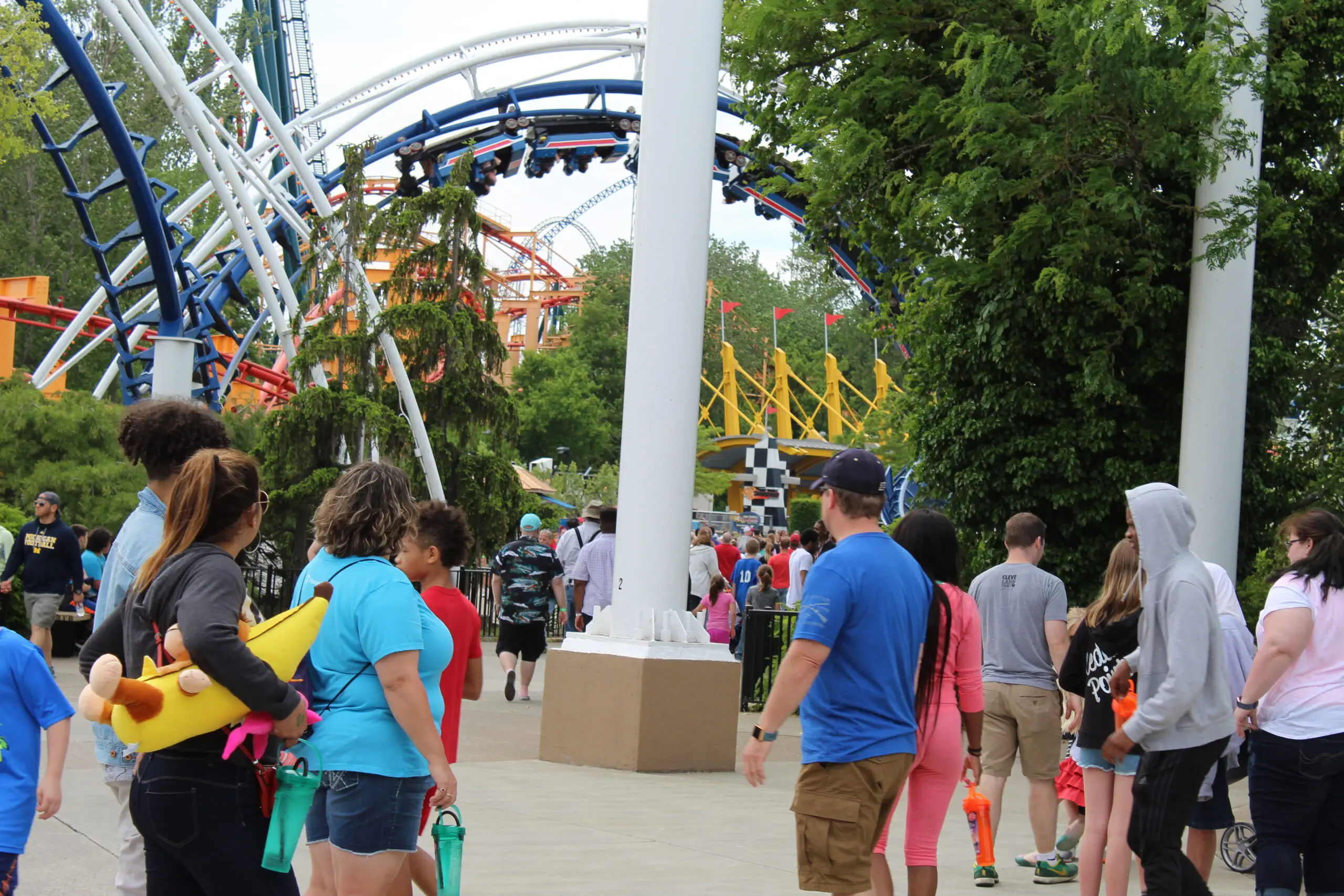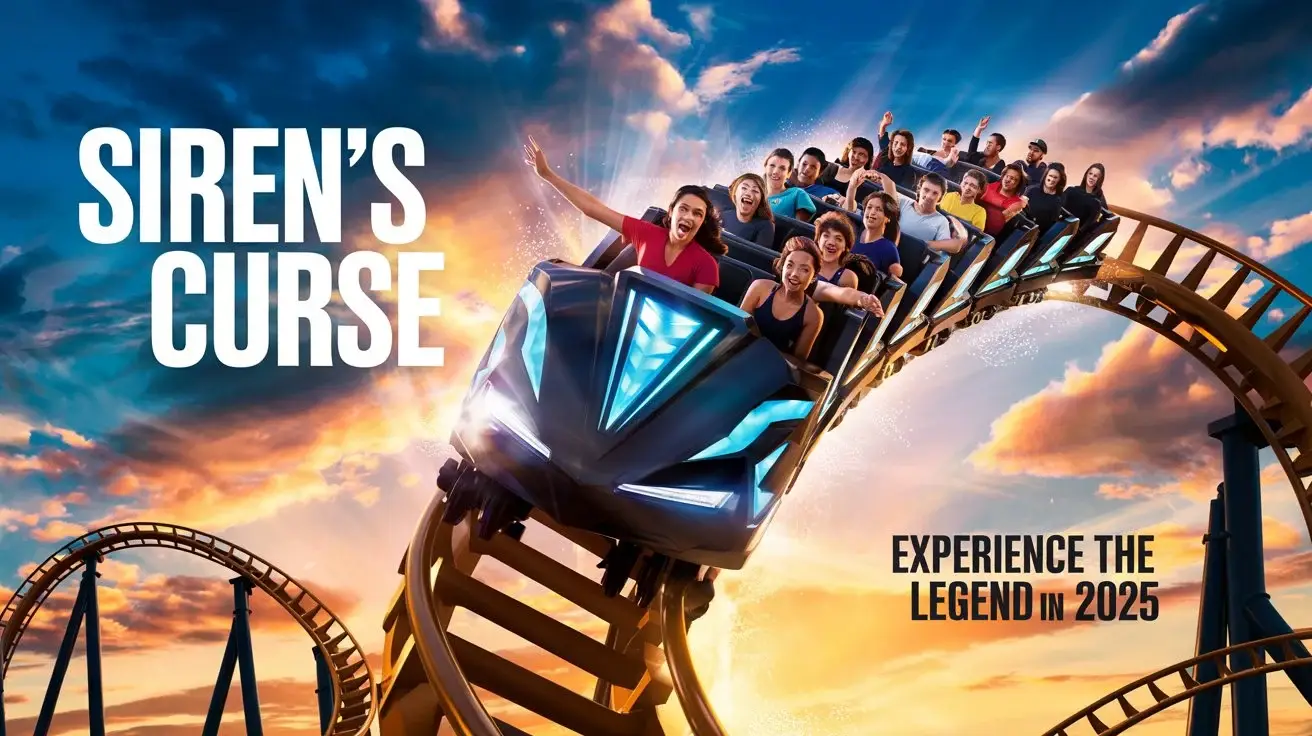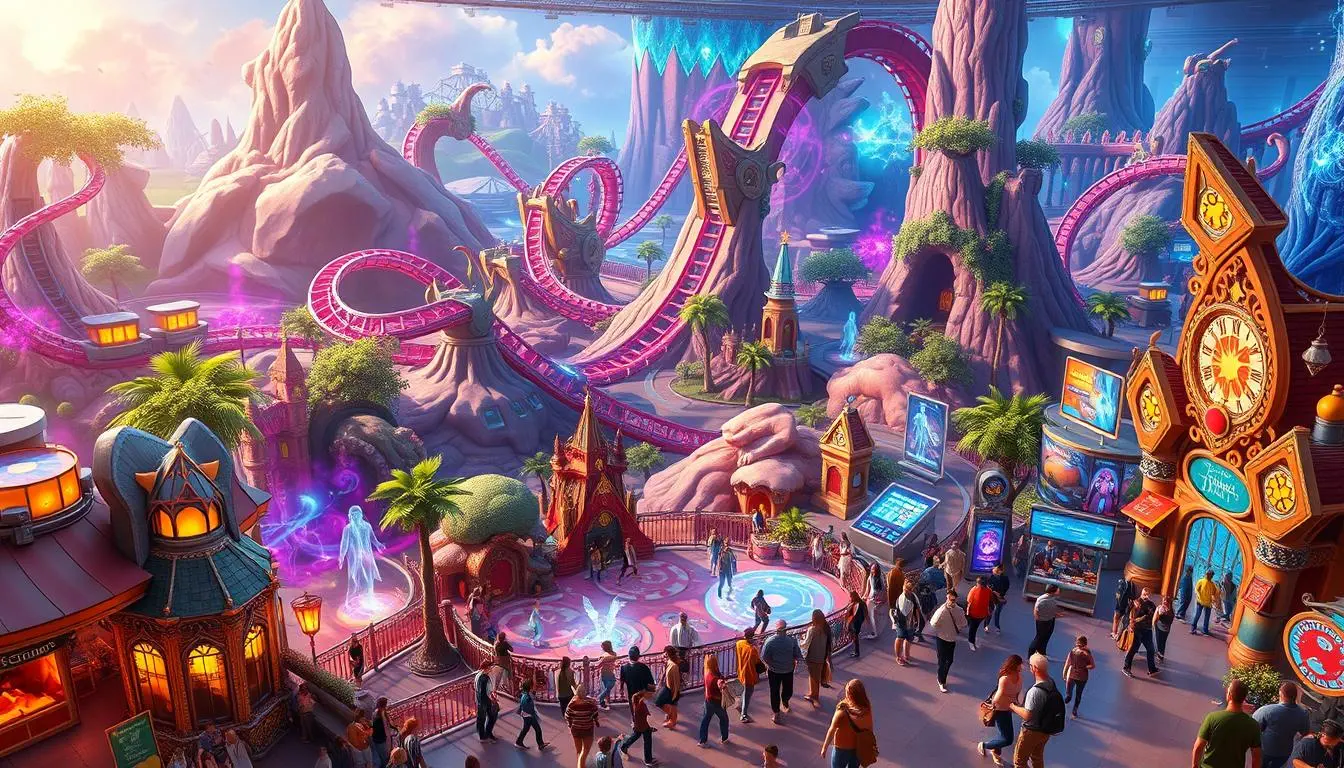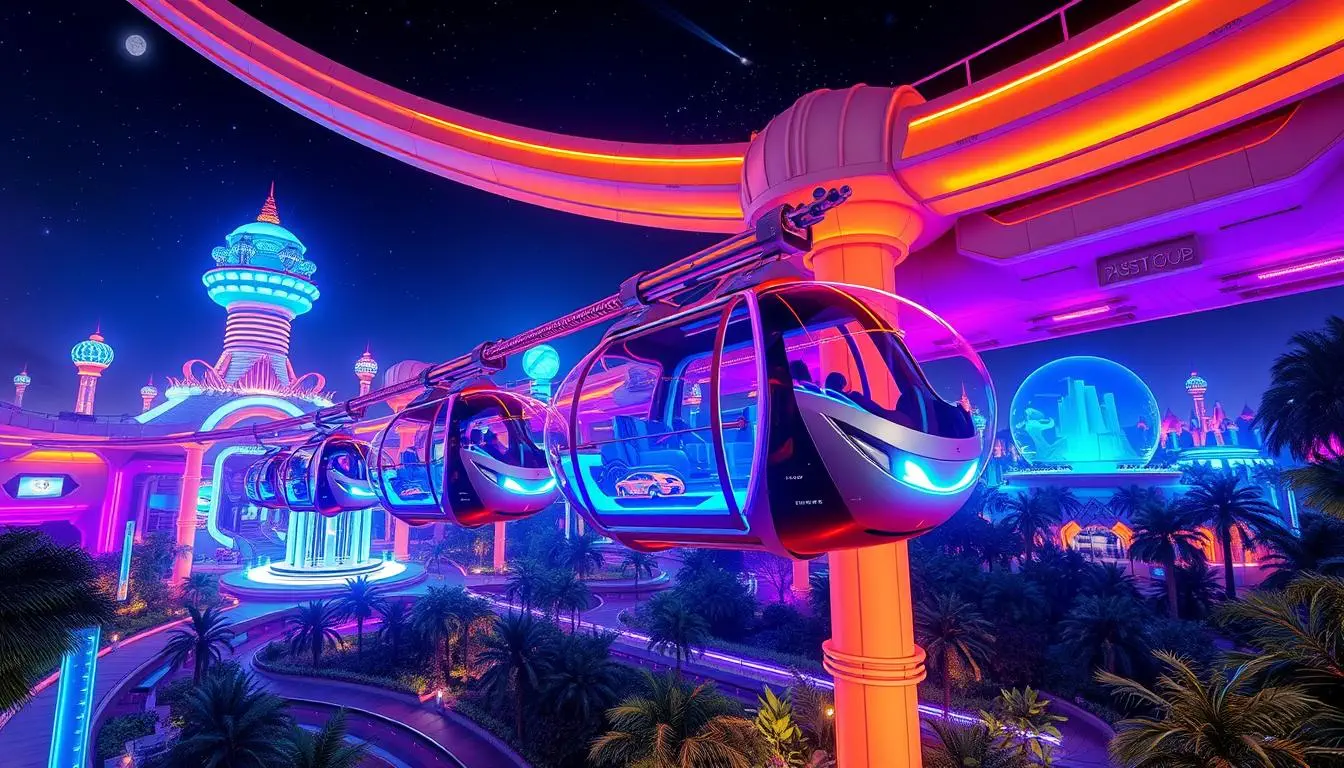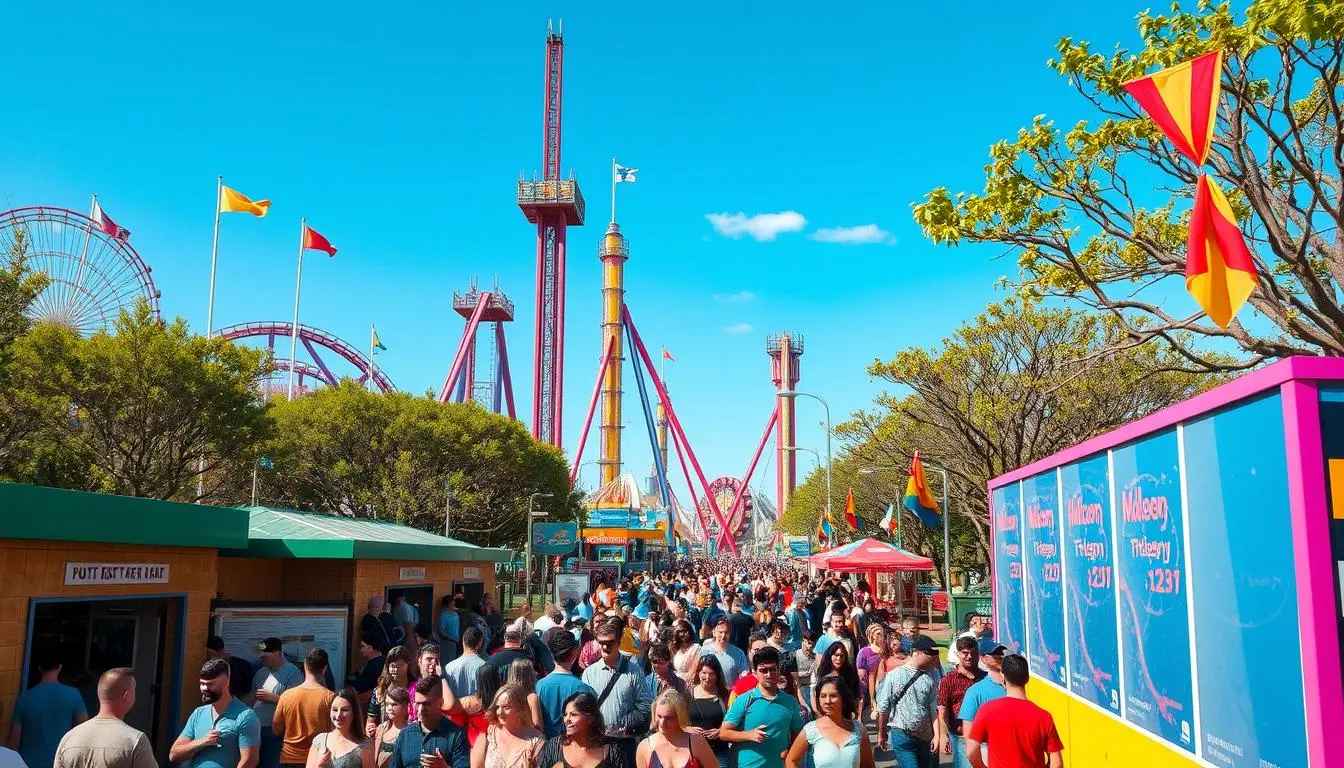From Lakeside Beach to “America’s Roller Coast”
Nestled on a unique peninsula jutting into Lake Erie in Sandusky, Ohio, Cedar Point stands as a premier North American amusement park and resort destination.1 As the second oldest operating amusement park on the continent 1, its history spans over a century and a half, mirroring the evolution of American leisure and entertainment itself. This report chronicles Cedar Point’s remarkable transformation, tracing its path from a modest public bathing beach established in 1870 3 to the internationally recognized “Roller Coaster Capital” 9 and, most recently, its integration into the newly formed Six Flags Entertainment Corporation. The narrative will explore its origins as a simple lakeside retreat, the pivotal era under George A. Boeckling’s visionary leadership, the challenges and revitalization efforts of the mid-20th century, the adrenaline-fueled “coaster wars” period under Cedar Fair’s stewardship, and its current position within the amusement park industry landscape.
The Birth of a Resort: Cedar Point’s Early Years (1870-1896)
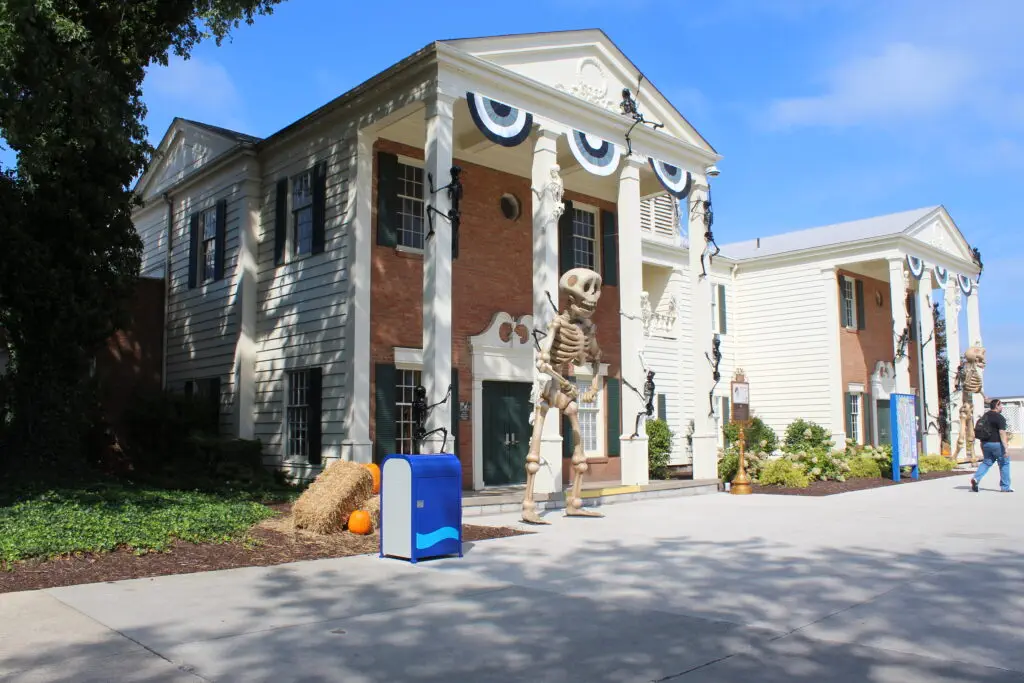
Before becoming a destination for amusement seekers, the Cedar Point peninsula, aptly named for its abundant cedar trees 3, served primarily as grounds for fishing and hunting.1 Its geographical setting within the Lake Erie region is intertwined with the history of Ohio’s “Firelands”—lands granted to Connecticut residents whose homes were destroyed during the Revolutionary War.2 Early legal documents first mention the name “Cedar Point” in 1831.10 The peninsula even played a strategic role during the American Civil War, housing artillery to defend the nearby Johnson’s Island prison camp for Confederate soldiers.2
The genesis of Cedar Point as a recreational spot can be traced to Louis Zistel, a German immigrant and local businessman.3 Zistel operated boats, initially under government contract to transport Confederate prisoners.2 Following the war, seeking new uses for his vessels, he recognized the potential of the peninsula’s attractive beach, spurred perhaps by local newspaper editorials calling for such development.1 In the summer of 1870, Zistel established rudimentary attractions: a small beer garden, a bathhouse for swimmers, and a dance floor.1 He began ferrying locals from Sandusky across the bay aboard his steamboat, the “Young Reindeer,” charging 25 cents for the trip.1 This modest venture is widely acknowledged as the beginning of commercial tourism on the Cedar Point peninsula.3
Cedar Point’s emergence coincided with broader societal shifts in the late 19th century. The rise of an American middle class with increased leisure time, coupled with advancements in transportation like railroads and steamships, fueled the popularity of lakeside and seaside resorts.3 Lake Erie’s south shore, including islands like Kelleys and South Bass, became a favored vacation area known for freshwater bathing.3 Cedar Point’s initial success was thus built upon fulfilling this growing public desire for accessible recreation, offering the right kind of destination at the right time.
The resort’s popularity grew steadily, albeit slowly at first, even stagnating in the mid-1870s.12 By the 1880s, local newspapers noted that “sailing and bathing parties to Cedar Point are all the rage”.1 Entrepreneurs responded to the increasing demand. James West opened additional bathhouses near the beach in 1878 or 1879.3 A more significant expansion occurred in 1882 when Benjamin F. Dwelle and Captain William Slackford leased land on the peninsula. They constructed eight new bathhouses, a dance hall, and wooden walkways, cleared brush, added picnic tables, and even built a baseball diamond.2 Transportation improved with steamers like the “R.B. Hayes” and “Lutts” providing regular service.3 By the mid-1880s, Cedar Point had evolved into a recognizable resort with multiple buildings and attractions.12
Further developments marked the late 1880s and early 1890s. The impressive Grand Pavilion opened in 1888, a large structure featuring an auditorium, bowling alleys, dining facilities, and porches, signifying a major upgrade in amenities.6 Electric lighting arrived around 1889 or 1891, enhancing the visitor experience.6 The park welcomed its very first roller coaster in 1892, the Switchback Railway. Built by the American Railway Coaster Company, it was a simple gravity-powered ride, standing 25 feet tall and reaching a top speed of just 10 miles per hour.6 The beach itself saw additions like a pony track, diving platforms, a water toboggan, a water trapeze, and bicycle boats by 1894, diversifying the recreational offerings.6
The Boeckling Era: Forging a Premier Destination (1897-1931)
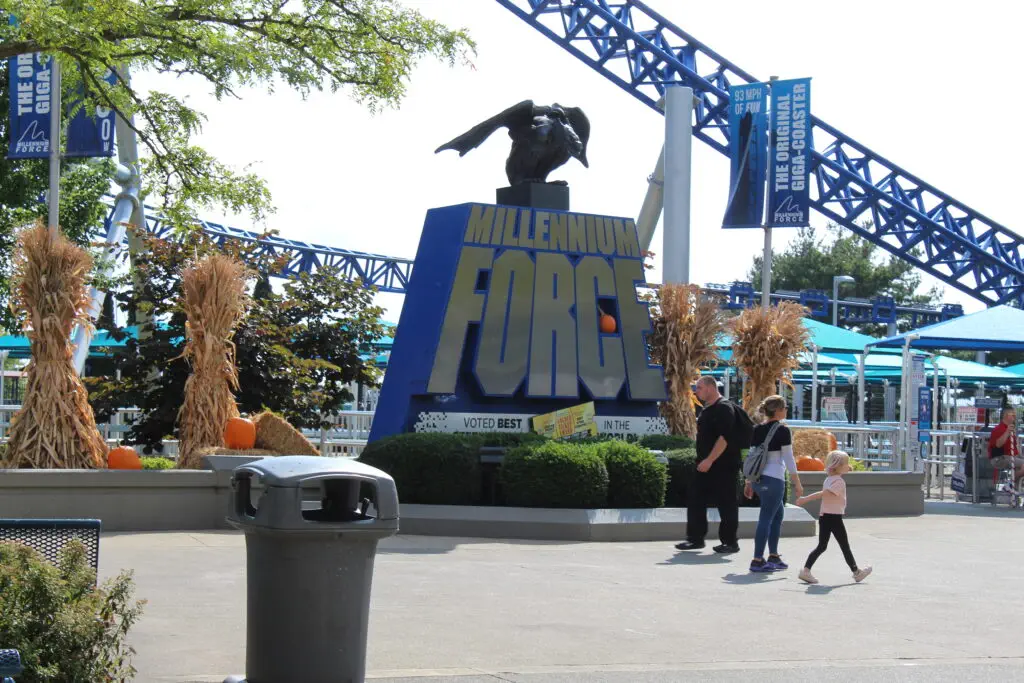
Despite its growth, Cedar Point faced challenges. Aggressive competition and a national economic recession in the 1890s caused the resort’s fortunes to decline, leading to financial losses by 1897 and casting doubt on its future.12 This period of uncertainty prompted a pivotal change in ownership. In 1897, the existing owners (Adam J. Stoll, Jacob Kuebeler, Louis Adolph, and Charles Bretz) sold their interests for $256,000 to the newly formed Cedar Point Pleasure Resort Company of Indiana.1 This company had ties to the Lake Erie and Western Railroad, reflecting the ongoing link between transportation and resort development.3
Crucially, the new ownership appointed George Arthur Boeckling as the park’s general manager.1 Born in Indiana to German immigrants, Boeckling had a background in sales (ice boxes), wholesale lumber, and real estate.12 Though lacking formal education beyond grade school 21, he possessed extraordinary vision, business acumen, and a flair for showmanship.2 From his arrival in 1897 until his death in 1931 1, Boeckling masterminded Cedar Point’s transformation from a regional picnic spot into a nationally recognized, premier amusement park and resort destination, favorably comparing it to established resorts like Atlantic City.3
Boeckling understood that creating a top-tier destination required significant investment in infrastructure and image. He embarked on an ambitious building program, constructing accommodations that conveyed scale and luxury. The modest Bay Shore Hotel opened in 1899 1, followed by the 55-room White House Hotel in 1901 (remodeled and renamed “The Cedars” in 1915).1 The crown jewel was the magnificent Hotel Breakers, which opened its doors in 1905. With 600 rooms, ornate Victorian architecture, and extensive amenities, it was one of the largest and most lavish hotels in the Midwest, immediately elevating the resort’s prestige.1 Alongside the hotels, Boeckling commissioned the enormous Coliseum in 1906. This two-story structure housed refreshment stands and various amusements on the ground floor, with a massive ballroom and skating rink above, becoming a central hub for entertainment.1 The Crystal Rock Palace also opened in 1905 to serve food and beverages.6
Boeckling didn’t just build structures; he curated an experience. In 1906, a new dedicated midway, known as the “Amusement Circle,” was constructed to link the main pier with the beach area, consolidating rides and attractions.3 Early motion pictures like “The Great Train Robbery” were shown.6 New rides were steadily added, including the Figure-Eight Roller Toboggan in 1902 1, later followed by coasters like Dip the Dips (1908), Leap the Dips (1912), and Leap Frog Railway (1917).3 Other popular amusements included a Circle Swing, fun houses like Noah’s Ark, and shooting galleries.3
Recognizing both practical needs and opportunities for unique attractions, Boeckling addressed the peninsula’s swampy areas and mosquito problem in 1904 by hiring the Detroit Dredging Company.3 They created a network of interconnected lagoons, draining the land while simultaneously providing a scenic waterway for passenger boats and coal transport.3 This practical solution became one of the park’s signature, picturesque features, enhancing the resort’s ambiance and offering new recreational possibilities, correcting the lack of suitable calm water for boating.12
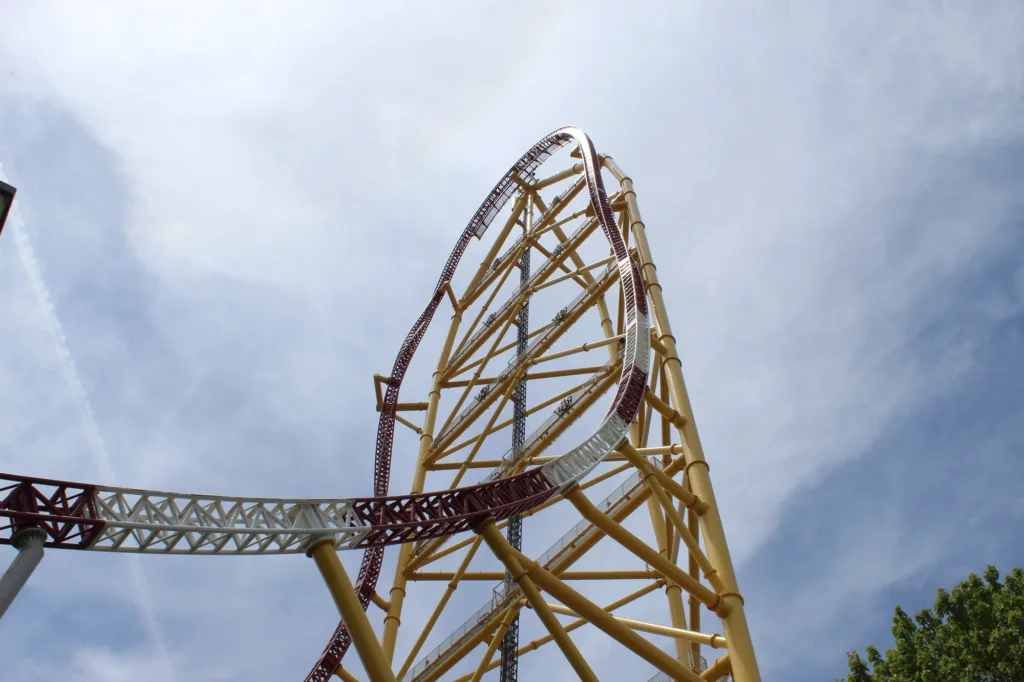
Improving accessibility was paramount to Boeckling’s strategy. He understood the importance of convenient transportation for attracting large crowds. Steamship service remained vital, with routes established from Cleveland by 1907.1 In 1909, the resort christened its own dedicated ferry, the impressive steel steamer “G.A. Boeckling,” capable of carrying 2,000 passengers and designed to operate in both directions without turning around.4 Railroads also brought thousands of visitors directly to the area.20 Recognizing the rise of the automobile, Boeckling pushed for a land connection. In 1911, plans were announced for a roadway, and the Cedar Point Chausee (later Causeway) opened to the public on July 19, 1914, linking the peninsula to mainland roads.1
Boeckling was a master promoter, leveraging events and spectacle to enhance Cedar Point’s reputation. In 1910, he paid aviation pioneer Glenn H. Curtiss to complete a record-setting 65-mile flight over Lake Erie, landing on the Cedar Point beach.2 In 1913, Notre Dame football players Knute Rockne and Gus Dorais worked as lifeguards at the resort and famously perfected the forward pass on the beach during their downtime.6 Boeckling actively courted conventions, bringing large groups like the Lions International (addressed by Helen Keller in 1925) and the International Bible Society to the resort.2 He booked top musical acts and big bands for the Coliseum ballroom.2 His public spirit and charitable contributions also fostered goodwill within the local Sandusky community.20 By the 1920s, Cedar Point was often hailed as the “Queen of American Watering Places” 11, a testament to Boeckling’s success in building not just a park, but a prestigious brand. His strategic vision, coupled with significant investments in infrastructure, attractions, transportation, and image, firmly established Cedar Point’s foundation for enduring success.
Table 1: Key Developments Under George A. Boeckling (1897-1931)
| Year | Development | Significance/Impact |
| 1897 | Boeckling assumes management | Marks the beginning of transformative leadership, rescuing the park from financial decline.3 |
| 1899 | Bay Shore Hotel opens | First major hotel addition under Boeckling.6 |
| 1902 | Figure-Eight Roller Toboggan opens | Second coaster in park history, early thrill attraction.1 |
| 1904 | Lagoons constructed | Solved drainage/mosquito issues, created scenic waterway and boating opportunities.3 |
| 1905 | Hotel Breakers opens | Landmark 600-room luxury hotel, significantly boosted resort capacity and prestige.1 |
| 1906 | Coliseum opens | Massive entertainment venue with ballroom, skating rink; central gathering place.1 |
| 1906 | Amusement Circle midway built | Consolidated rides and attractions, creating a dedicated amusement zone.3 |
| 1909 | Steamer “G.A. Boeckling” christened | Dedicated, high-capacity ferry improved transportation from Sandusky.4 |
| 1910 | Glenn Curtiss over-water flight lands at CP | Major publicity event showcasing the park’s prominence.2 |
| 1912 | Leap the Dips roller coaster opens | Significant early wooden coaster.3 |
| 1914 | Cedar Point Chausee (roadway) opens | Provided crucial automobile access to the peninsula.1 |
| 1929 | Cyclone wooden roller coaster opens | Major, thrilling coaster addition before the Depression era.1 |
Survival and Stagnation: The Mid-20th Century (1932-1950s)
George Boeckling’s death in 1931 marked the end of an era of unprecedented growth and vision.1 Edward Smith assumed management duties 3, and the G.A. Boeckling Company continued to operate the park 18, but the subsequent decades proved challenging. The Great Depression cast a long shadow over the national economy, severely impacting the leisure industry.1 Expansion ground to a halt; the Tumble Bug ride, added in 1934, was one of the few new attractions during the 1930s.1 The aging Leap the Dips coaster was demolished mid-decade.3 Boeckling’s earlier strategies of slashing admission prices and booking popular big bands for the Coliseum ballroom helped the park weather the initial storm 16, and a modernization of the ballroom in the late 1930s provided a crucial revenue stream that kept Cedar Point operating.3 The financial strain was immense, however, bringing the resort to the brink of being sold to the state of Ohio for $3 million in the late 1930s.3
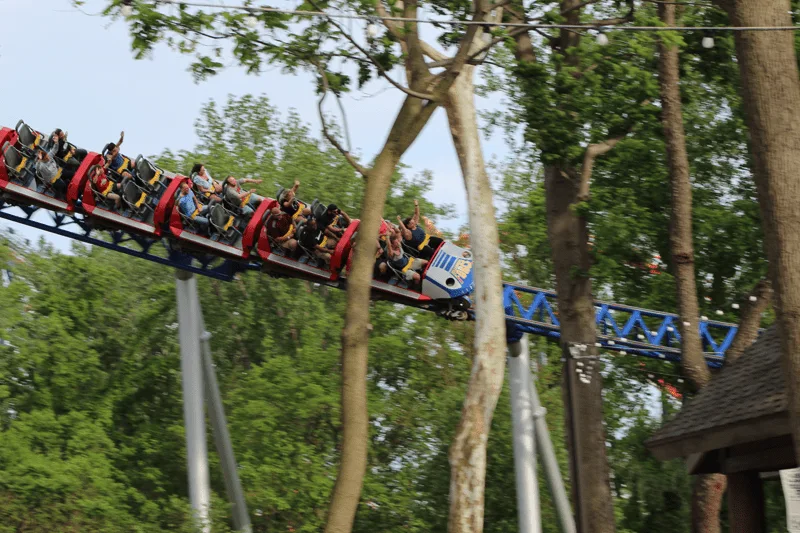
World War II brought further constraints, and by the war’s end, Cedar Point was in a state of significant decline and disrepair.3 Years of deferred maintenance took their toll. The wooden structure of the Cyclone roller coaster, once a premier attraction, was rotting.3 Boardwalk planks were cracked, and the fishing dock required urgent attention.3 Reflecting its poor condition, the Cyclone was finally razed in 1951, leaving Cedar Point without a roller coaster for the first time in decades.3 Regular passenger steamer service from Sandusky, long a lifeblood of the resort, was discontinued in 1952, and the venerable “G.A. Boeckling” ferry was sold off.6 New additions were minimal, including the classic Midway Carousel installed in 1946 (now the park’s oldest operating ride) and a few smaller attractions like the Laff-in-the-Dark funhouse, Rocket Ships, and Loop-A-Plane.3 A culinary tradition began in 1942 with the arrival of Momma Berardi’s Home Made French Fries, which would remain a park staple for decades.3
The 1950s represented a low point. Attendance dwindled, and the park’s appearance grew increasingly shabby.11 The situation became so dire that plans were seriously considered to close Cedar Point permanently and redevelop the valuable peninsula property.3 This period also marked the end of the Kuebeler family’s long association with the park’s ownership, dating back to the pre-Boeckling era.12 However, significant public outcry arose against the closure plans, demonstrating the deep affection locals held for the historic resort. The public pressure, reportedly including a statement from Ohio’s governor that the state might intervene to purchase the park, helped stave off its demise.11 This critical juncture underscored the vulnerability of even established leisure businesses to economic downturns and the absolute necessity of continuous reinvestment. Cedar Point’s survival ultimately depended on both community support and the arrival of new ownership willing to inject substantial capital and implement a new vision.
Revitalization and the Modern Park Emerges (Late 1950s-1970s)
The turning point for Cedar Point arrived around 1957 with the acquisition of the park by a group of investors, notably including George Roose and Emile Legros.3 Recognizing the park’s potential despite its dilapidated state, the new ownership immediately initiated a period of significant reinvestment and strategic change. Over $1.2 million was spent in 1959 alone to refresh the park’s aging infrastructure.3 This included repainting the landmark Hotel Breakers, the Grand Pavilion, and the Coliseum; installing new admission gates; undertaking a major restoration of the Breakers; demolishing neglected cottages and outdated structures like the old bathhouses and powerhouse; and constructing new, modern facilities in their place.3
Crucially, the new management addressed the park’s accessibility. The Cedar Point Chausee was significantly improved and modernized, reopening as the Cedar Point Causeway on June 12, 1957.3 This vastly improved automobile access to the peninsula. Complementing this was the construction of the Cedar Point Marina in 1959, one of the largest on the Great Lakes, which broadened the resort’s appeal to boaters and added another dimension to its offerings.3 These infrastructure projects were fundamental shifts, unlocking the potential for mass attendance in the automobile age.
Beyond physical repairs, the late 1950s and 1960s saw a fundamental pivot in Cedar Point’s identity. The new owners moved away from the traditional, more passive resort model and embraced the emerging concept of the modern American amusement park, drawing inspiration from the success of Disneyland.11 They hired Truman Woodworth, who had experience working on Disneyland’s design 11, and began incorporating new types of attractions and operational approaches. A sleek Monorail became the park’s most popular ride in 1959.3 The park added its first roller coaster since the Cyclone’s removal, the Wild Mouse, also in 1959.3 Other additions reflecting the shift towards active amusement included Cadillac Cars (1960), the Sky Ride (1961), and Scrambler (1960).3 Employees were professionalized with uniforms 11, and “pay one price” admission passes became increasingly common, simplifying the guest experience.3
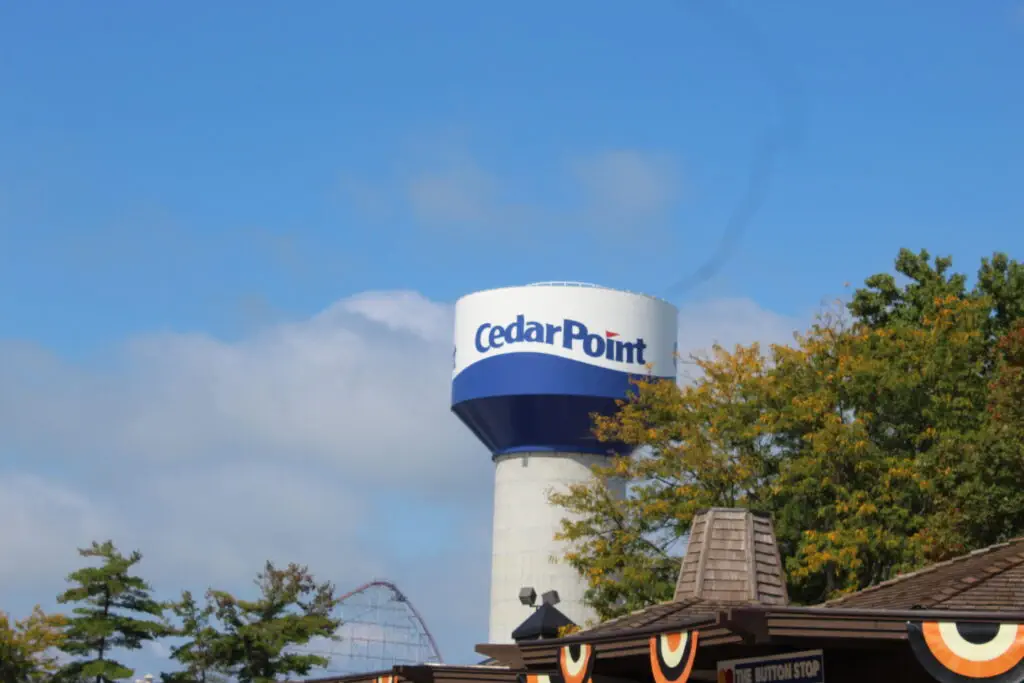
The focus on ride experiences intensified through the 1960s. In 1964, Cedar Point opened the Blue Streak roller coaster, designed by the renowned Philadelphia Toboggan Company.3 This classic wooden coaster remains the park’s oldest operating coaster and marked the true beginning of its modern ride era. It was followed in 1969 by the Cedar Creek Mine Ride, an early Arrow Development steel coaster utilizing tubular track technology.3 The park also began developing themed areas with the opening of Frontier Town in 1968 6, adding attractions like the Cedar Point & Lake Erie Railroad (opened 1963) 3 and the popular Jungle Larry’s African Safari animal exhibit (1965-1994).3
Cedar Point celebrated its Centennial in 1970 with the opening of the Centennial Theatre (later renamed), several new flat rides including the WildCat coaster, the relocation and enhancement of Kiddy Kingdom, and the debut of the Sealand marine exhibit.3 The 1970s cemented the park’s new direction, laying the groundwork for its future “Roller Coaster Capital” status. Following the retirement of George Roose (Robert L. Munger Jr. became president around 1975/1979 3), the park embarked on adding major, record-breaking coasters. The Jumbo Jet coaster arrived in 1972.3 In 1976, the iconic red, white, and blue Corkscrew debuted, making history as the world’s first roller coaster with three inversions and the first to span a midway.3 Just two years later, in 1978, Gemini opened, a massive racing wooden coaster (built with steel supports) advertised as the tallest, fastest, and steepest roller coaster on the planet at the time.3 This era of strategic investment in infrastructure, modern ride technology, and themed experiences successfully revitalized Cedar Point, transforming it from a near-failure into a thriving modern amusement park poised for further growth.
The Cedar Fair Reign: Roller Coaster Capital (1983-2024)
The trajectory of Cedar Point in the late 20th and early 21st centuries became inextricably linked with the rise of its parent company, Cedar Fair Entertainment Company. The foundation for Cedar Fair was laid in 1978 when Cedar Point acquired Valleyfair, an amusement park in Shakopee, Minnesota.18 In 1983, the parent entity Cedar Fair, L.P. was formally established, its name cleverly derived by combining “Cedar” from Cedar Point and “Fair” from Valleyfair.10 Robert L. Munger Jr. served as the initial CEO 27, succeeded by Richard L. Kinzel in 1986 due to Munger’s declining health.27 Cedar Fair became a publicly traded master limited partnership in 1987.18
Under the leadership of Cedar Fair, particularly during Kinzel’s long tenure, Cedar Point adopted and perfected a highly effective, albeit capital-intensive, strategy: cementing its identity and driving attendance through the relentless addition of record-breaking roller coasters. This approach, often dubbed the “Coaster Wars,” positioned Cedar Point as a premier destination for thrill-seekers worldwide and solidified its famous moniker, “America’s Roller Coast”.5 Each major new coaster was designed not just to provide thrills, but to generate significant media buzz and attract visitors eager to experience the latest “tallest,” “fastest,” or “first-of-its-kind” attraction.
The opening salvo in this modern coaster arms race was the Magnum XL-200 in 1989. Designed by Arrow Dynamics, it shattered records as the world’s first “hypercoaster,” exceeding 200 feet in height, and claiming titles for the tallest, fastest, and steepest complete-circuit coaster at the time.5 Magnum is widely credited with igniting the intense competition among parks to build ever-larger and faster coasters and is recognized as an ACE Roller Coaster Landmark.5
This was followed by a series of major coaster installations, many claiming world records upon opening:
- Mean Streak (1991): A massive wooden coaster, the tallest and fastest of its kind when it debuted.27 It later developed a notoriously rough ride and was eventually transformed.
- Raptor (1994): A Bolliger & Mabillard inverted coaster (where the train hangs below the track), setting records for height and speed for its type.27
- Mantis (1996): Another B&M creation, this time a stand-up coaster that broke records for height and speed in its category.27 It was later converted to a floorless coaster named Rougarou in 2015.36
- Millennium Force (2000): A watershed moment, this Intamin-designed “gigacoaster” was the first to break the 300-foot height barrier. Its 310-foot lift hill, 93 mph speed, and smooth, high-speed turns redefined the coaster experience and garnered widespread acclaim, consistently ranking among the world’s best steel coasters.5
- Top Thrill Dragster (2003): Intamin pushed the limits again, creating the world’s first “stratacoaster,” exceeding 400 feet. Its hydraulic launch accelerated riders from 0 to 120 mph in under 4 seconds, rocketing them up a 420-foot vertical tower.5 A serious incident in 2021 involving falling debris led to its closure.24 It was subsequently redesigned and reopened in 2024 as Top Thrill 2, featuring multiple launches and retaining its status as a strata coaster.36
- Maverick (2007): Breaking from the pure height/speed formula, this Intamin “blitz coaster” focused on intensity, featuring quick launches, tight turns, airtime hills, and inversions, all packed into a lower-profile layout that closely follows the terrain.5
- Gatekeeper (2013): A B&M wing coaster, where riders sit on either side of the track. It set records for its type and created an iconic park entrance element with its trains soaring through keyhole towers over the main gate.22
- Valravn (2016): A B&M dive coaster, establishing new records for height, speed, and length for this coaster type, known for its vertical drops.22
- Steel Vengeance (2018): Cedar Point partnered with Rocky Mountain Construction (RMC) to transform the aging Mean Streak into a steel-tracked hybrid coaster. Steel Vengeance debuted to rave reviews, breaking numerous world records for hybrid coasters and quickly becoming a fan favorite known for its relentless airtime and inversions.5
Other notable coasters during this era include the suspended Iron Dragon (1987) 27, the inverted impulse coaster Wicked Twister (2002-2021) 36, the family coasters in Camp Snoopy (Woodstock Express, 1999) 27, and the spinning Wild Mouse (2023).36 The focus on record-breaking coasters successfully cemented Cedar Point’s brand identity as the ultimate thrill destination, drawing enthusiasts from across the globe.
Table 2: Cedar Point’s Major Roller Coasters (Modern Era, 1964-Present)
| Year Opened | Coaster Name | Manufacturer | Type/Model | Key Feature/Record at Opening | Status (as of late 2024) |
| 1964 | Blue Streak | Philadelphia Toboggan Co. | Wooden Out-and-Back | First major coaster of revitalization era | Operating |
| 1969 | Cedar Creek Mine Ride | Arrow Development | Steel Mine Train | Early steel tubular track coaster | Operating |
| 1976 | Corkscrew | Arrow Development | Steel Looping | World’s first with 3 inversions; first to span midway | Operating |
| 1978 | Gemini | Arrow Development | Steel Hybrid Racing | Tallest, fastest, steepest racing coaster at opening | Operating |
| 1987 | Iron Dragon | Arrow Development | Steel Suspended | Swinging cars suspended below track | Operating |
| 1989 | Magnum XL-200 | Arrow Dynamics | Steel Hypercoaster | World’s first hypercoaster (>200 ft); tallest, fastest, steepest | Operating |
| 1991 | Mean Streak | Dinn Corporation | Wooden Twister | Tallest & fastest wooden coaster at opening | Converted (Steel Vengeance) |
| 1994 | Raptor | Bolliger & Mabillard (B&M) | Steel Inverted | Tallest & fastest inverted coaster at opening | Operating |
| 1996 | Mantis | B&M | Steel Stand-Up | Tallest & fastest stand-up coaster at opening | Converted (Rougarou) |
| 1999 | Woodstock Express | Vekoma | Steel Family | Anchor ride for Camp Snoopy | Operating |
| 2000 | Millennium Force | Intamin | Steel Gigacoaster | World’s first gigacoaster (>300 ft); tallest & fastest full-circuit | Operating |
| 2002 | Wicked Twister | Intamin | Steel Inverted Impulse | Double-twisting vertical spikes | Removed (2021) |
| 2003 | Top Thrill Dragster | Intamin | Steel Strata Coaster (Launch) | World’s first stratacoaster (>400 ft); tallest & fastest (120 mph) | Converted (Top Thrill 2) |
| 2007 | Maverick | Intamin | Steel Blitz/Terra (LSM Launch) | Intense layout, multiple launches, beyond-vertical drop | Operating |
| 2013 | Gatekeeper | B&M | Steel Wing | Tallest, fastest, longest wing coaster; iconic entrance element | Operating |
| 2015 | Rougarou | B&M | Steel Floorless | Conversion of Mantis (stand-up) | Operating |
| 2016 | Valravn | B&M | Steel Dive | Tallest, fastest, longest dive coaster at opening | Operating |
| 2018 | Steel Vengeance | Rocky Mountain Construction | Steel Hybrid (I-Box) | Conversion of Mean Streak; multiple hybrid coaster records | Operating |
| 2023 | Wild Mouse | Zamperla | Steel Spinning | Modern take on classic wild mouse design | Operating |
| 2024 | Top Thrill 2 | Zamperla (modifying Intamin) | Steel Strata Coaster (LSM Launch) | World’s tallest & fastest triple-launch strata coaster | Operating |
While coasters dominated the headlines, Cedar Fair also invested significantly in expanding Cedar Point’s resort offerings and diversifying its attractions. The Soak City water park opened in 1988 27 and underwent a major transformation and rebranding into Cedar Point Shores in 2017.36 Hotel capacity grew with additions like Sandcastle Suites (1990) 27, Breakers East (1995) 27, Breakers Tower (1999) 27, the off-site Breakers Express (now Cedar Point’s Express Hotel) 36, and the upscale Lighthouse Point cottages and cabins near the historic lighthouse (2001).13 The year-round Castaway Bay indoor waterpark resort opened in 2004 36, and Cedar Fair acquired and renovated the nearby Sawmill Creek Resort.36 Family offerings were enhanced with Camp Snoopy (1999).27 Other additions (some later removed) included the Challenge Park activity complex 27, the Dinosaurs Alive! walk-through exhibit 36, and the interactive Forbidden Frontier on Adventure Island.36 Most recently, the park revitalized a section of its midway into The Boardwalk (2023), featuring the new Wild Mouse coaster and the Grand Pavilion Restaurant & Bar, nodding to the park’s history.36
This era wasn’t without challenges. A fire destroyed the Candle Shop in 1976, though it was rebuilt for the season.41 (The famous G.A. Boeckling steamer, long retired from service, was tragically destroyed by a suspicious fire in Toledo during a restoration attempt in 1989 4). The most significant recent challenge was the COVID-19 pandemic in 2020. It forced a delayed opening, led to what industry experts called “catastrophic” revenue losses, and postponed the park’s planned 150th-anniversary celebrations until 2021.42 The pandemic starkly highlighted the park’s immense economic importance to Sandusky and the surrounding region, with city officials noting the devastating impact a prolonged closure would have on local businesses, residents, and the city budget, which relies heavily on park-related taxes.42 The delayed 150th-anniversary celebration in 2021 featured special parades, merchandise, and promotions like the “Ticket of a Lifetime” contest.43 The 2021 Top Thrill Dragster incident also presented a major operational and public relations challenge, leading to the ride’s multi-year closure and eventual reimagining.24
Throughout this period, Cedar Fair itself grew substantially, acquiring numerous other amusement parks across North America (including Dorney Park, Worlds of Fun, Knott’s Berry Farm, Michigan’s Adventure, the Paramount Parks chain, and Schlitterbahn water parks) 18, becoming a major industry player with its headquarters located in Sandusky, Ohio.18 Cedar Point, as the original park and home to many of the company’s signature investments, remained the undisputed flagship.
Industry Standing and the Path Forward

Through decades of innovation and strategic investment, Cedar Point solidified its reputation as “America’s Roller Coast”.5 This nickname, born from its impressive collection of roller coasters, became synonymous with the park’s identity, fueled by the relentless pursuit of world records during the Cedar Fair era.5 The park consistently garnered industry accolades, most notably being named the “Best Amusement Park in the World” by Amusement Today readers for an unprecedented 16 consecutive years (though this streak ended).24 Several of its coasters, like Magnum XL-200, received landmark status from American Coaster Enthusiasts (ACE).35 Cedar Point established itself as an innovator, pioneering new coaster categories like the hypercoaster, gigacoaster, and stratacoaster 5, and boasting one of the highest hourly ride capacities in the industry.16
Beyond the thrills, Cedar Point remains a significant economic driver for Northern Ohio. It is a major seasonal employer, hiring around 7,000 associates each year for positions ranging from ride operations and food service to security and hotel staff.9 The park’s economic health is deeply intertwined with the prosperity of Sandusky and the surrounding communities.25 Recognizing the importance of skilled leadership in the hospitality industry, Cedar Fair partnered with Bowling Green State University Firelands Campus to develop customized leadership training programs for its employees, aiming to enhance guest experiences across its properties.32
A new chapter began on July 1, 2024, with the completion of the announced “merger of equals” between Cedar Fair and its longtime rival, Six Flags Entertainment Corporation.9 This transaction created the largest amusement park operator in North America by park count, overseeing a combined portfolio of 42 parks (27 amusement, 15 water) and 9 resort properties across 17 U.S. states, Canada, and Mexico.9 The combined company, valued at approximately $8 billion (including debt), operates under the Six Flags name but trades on the NYSE under Cedar Fair’s former ticker symbol, FUN.18 Former Cedar Fair unitholders received a majority stake (51%) in the new entity.19 The leadership structure reflects the merger’s nature, with former Cedar Fair CEO Richard Zimmerman serving as President and CEO of the new Six Flags, and former Six Flags CEO Selim Bassoul taking the role of Executive Chairman of the Board.9 While the corporate headquarters relocated to Charlotte, North Carolina, the company stated that significant finance and administrative operations would be maintained in Sandusky, Ohio.19
The merger promises potential benefits, including operational efficiencies, cost savings through economies of scale, enhanced technological platforms, increased financial flexibility for investments in new rides and park upgrades, and greater geographic diversification.9 There are also opportunities for cross-promotion and leveraging intellectual property across the combined portfolio, which includes Cedar Fair’s Peanuts license and Six Flags’ partnerships with DC Comics and Looney Tunes.9 An “All Park Passport” add-on for season passes was introduced shortly after the merger, allowing access to both legacy Cedar Fair and Six Flags parks.25 However, the merger also presents challenges, including the complexities of integrating two large organizations, potential antitrust scrutiny requiring park divestitures in overlapping markets, the impact of restructuring on employees, and the critical task of maintaining the unique brand identities and loyal fanbases of the individual parks.47
This corporate realignment marks a significant shift for Cedar Point. For decades, it served as the crown jewel and operational heart of Cedar Fair, its success driving the company’s growth.18 Now, while still recognized as a historically significant founding park 19 and an iconic destination, it operates within a much larger corporate structure under the Six Flags banner, with the primary headquarters located elsewhere.19 Although park officials state operations continue as “business as usual” with no immediate branding changes planned 25, future decisions regarding investment priorities, branding strategies, and operational standards will inevitably be made within this broader context. The long-term impact on Cedar Point’s distinct “America’s Roller Coast” identity remains to be seen as the new Six Flags Entertainment Corporation seeks synergies and defines its unified vision.
Conclusion: A Legacy of Thrills and Transformation
Cedar Point’s 154-year history is a remarkable narrative of adaptation, innovation, and the enduring human desire for recreation and thrill. From its humble origins as a Lake Erie bathing beach in 1870 1, it blossomed under George A. Boeckling’s ambitious vision into a grand, nationally recognized resort.3 It weathered the storms of economic depression and war, facing near closure in the mid-20th century before embarking on a crucial revitalization that shifted its focus towards modern amusement.3 The subsequent era under Cedar Fair saw the park aggressively pursue and claim the title of “America’s Roller Coast,” relentlessly pushing the boundaries of thrill ride technology and cementing its global reputation.5 Now, it enters a new phase as a key property within the largest amusement park operator in North America, the newly merged Six Flags Entertainment Corporation.19
The park’s longevity stems from a confluence of factors: its unique and beautiful lakeside location 3, a deep-seated sense of tradition passed down through generations of visitors 51, a willingness to continuously innovate and reinvest (particularly in its ride arsenal) 5, and the resilience to adapt to changing economic conditions and visitor preferences.3 It remains a place where millions create lasting memories, whether experiencing cutting-edge thrills or enjoying long-established traditions.39 Cedar Point stands not only as a giant in the amusement industry but as a significant landmark in the history of American popular culture and leisure, a testament to over a century and a half of making people happy on the shores of Lake Erie. Its future, now intertwined with that of Six Flags, promises continued evolution in the dynamic landscape of entertainment.
Works cited
- Cedar Point, Ohio, US – InterPark, accessed April 10, 2025, https://interpark.co.uk/features/cedar-point-ohio-us/
- A History of Cedar Point – Summer 1967 – National Museum of the Great Lakes, accessed April 10, 2025, https://nmgl.org/a-history-of-cedar-point-summer-1967/
- Cedar Point – Wikipedia, accessed April 10, 2025, https://en.wikipedia.org/wiki/Cedar_Point
- G.A. Boeckling Building and Cedar Point Pier – Erie County Historical Society, accessed April 10, 2025, https://eriecountyohiohistory.org/g-a-boeckling-building-cedar-point-pier/
- Coaster Con 44 – American Coaster Enthusiasts (ACE), accessed April 10, 2025, https://www.aceonline.org/events/register.aspx?id=1632877
- Cedar Point Timeline 1870 – 1969, accessed April 10, 2025, https://www.cedarpoint.com/blog/media-center/cedar-point-timeline-1870-1969
- Park History – Insiders of the Point, accessed April 10, 2025, https://www.insidersofthepoint.com/park-history.html
- www.cedarpoint.com, accessed April 10, 2025, https://www.cedarpoint.com/blog/media-center/cedar-point-timeline-1870-1969#:~:text=1870%3A%20Cedar%20Point%20opens%20as,eight%20bathhouses%20also%20built%20there.
- Trip Reports/News – Insiders of the Point, accessed April 10, 2025, https://www.insidersofthepoint.com/trip-reportsnews.html
- The History of Cedar Point – Roller Coaster Freak, accessed April 10, 2025, http://www.rollercoasterfreak.com/Cedar_Point/History.html
- What a Ride! | Lake Erie Living, accessed April 10, 2025, https://lakeerieliving.com/articles/2020-mayjune/what-a-ride/
- Hayes Historical Journal: Cedar Point – Rutherford B. Hayes …, accessed April 10, 2025, https://www.rbhayes.org/research/hayes-historical-journal-cedar-point/
- History among the thrills at Cedar Point | Ohio, The Heart of It All, accessed April 10, 2025, https://ohio.org/travel-inspiration/articles/history-among-the-thrills-at-cedar-point
- Cedar Point History – 1900’s – PointBuzz, accessed April 10, 2025, https://pointbuzz.com/history/Decade/1900
- 17-22 Cedar Point – Remarkable Ohio, accessed April 10, 2025, https://remarkableohio.org/marker/17-22-cedar-point/
- Cedar Fair, L.P. | Encyclopedia.com, accessed April 10, 2025, https://www.encyclopedia.com/books/politics-and-business-magazines/cedar-fair-lp
- Roller Coaster History – Insiders of the Point, accessed April 10, 2025, https://www.insidersofthepoint.com/roller-coaster-history.html
- Cedar Fair – Wikipedia, accessed April 10, 2025, https://en.wikipedia.org/wiki/Cedar_Fair
- Six Flags – Wikipedia, accessed April 10, 2025, https://en.wikipedia.org/wiki/Six_Flags
- George Arthur Boeckling – Wikipedia, accessed April 10, 2025, https://en.wikipedia.org/wiki/George_Arthur_Boeckling
- G.A. Boeckling, Cedar Point Visionary – Sandusky History, accessed April 10, 2025, http://sanduskyhistory.blogspot.com/2007/06/ga-boeckling-cedar-point-visionary.html
- Dreams from the Past: The Roller Coaster of Life at Cedar Point – CMBA News and Information – Cleveland Metropolitan Bar Association, accessed April 10, 2025, https://www.clemetrobar.org/?pg=CMBABlog&blAction=showEntry&blogEntry=62000
- The G.A. Boeckling – Sandusky History, accessed April 10, 2025, http://sanduskyhistory.blogspot.com/2014/06/the-ga-boeckling.html
- Thrills over theme: Cedar Point’s meteoric rise from regional resort to national flagship – Toledo Blade, accessed April 10, 2025, https://www.toledoblade.com/business/development/2024/08/02/thrills-over-theme-cedar-points-meteoric-rise-from-regional-resort-amusement/stories/20240728028
- Legacy Cedar Fair, Six Flags parks merge into national brand – Toledo Blade, accessed April 10, 2025, https://www.toledoblade.com/business/development/2024/08/02/legacy-cedar-fair-six-flags-parks-merge-national-brand/stories/20240804040
- Ranking EVERY Coaster in Cedar Point’s Modern History, 1964-Present – YouTube, accessed April 10, 2025, https://m.youtube.com/watch?v=7mf0Ftfwz2I&pp=ygUNI3RyYWludGhyaWxscw%3D%3D
- Cedar Point Timeline 1970 – 1999, accessed April 10, 2025, https://www.cedarpoint.com/blog/media-center/cedar-point-timeline-1970-1999
- Cedar Point: The Story of America’s Roller Coast – YouTube, accessed April 10, 2025, https://www.youtube.com/watch?v=xMSIAk1Ighs
- G.A. Boeckling – CP&LE R.R., accessed April 10, 2025, https://cplerr.weebly.com/ga-boeckling.html
- All the Cedar Point Roller Coasters, Ranked – Belle Brita, accessed April 10, 2025, https://bellebrita.com/2018/06/cedar-point-roller-coasters/
- American Dream given shopping center award Zamperla tapped as operator, ride supplier for food park FEC, accessed April 10, 2025, https://www.jmhildebrandt.com/content/uploads/AT-Feb-2019-p34.pdf
- America’s Roller Coast – Bowling Green State University, accessed April 10, 2025, https://www.bgsu.edu/magazine/summer2014/americas-roller-coast.html
- Coaster Appreciation Series #14: Gatekeeper, Cedar Point : r/rollercoasters – Reddit, accessed April 10, 2025, https://www.reddit.com/r/rollercoasters/comments/72lhi3/coaster_appreciation_series_14_gatekeeper_cedar/
- [other] Coaster Wars Timeline : r/rollercoasters – Reddit, accessed April 10, 2025, https://www.reddit.com/r/rollercoasters/comments/l6lu05/other_coaster_wars_timeline/
- A Perfect Day at Cedar Point – Tough Cookie Travel, accessed April 10, 2025, https://toughcookietravel.com/cedar-point-amusement-park/
- Cedar Point Timeline 2000 – Present, accessed April 10, 2025, https://www.cedarpoint.com/blog/media-center/cedar-point-timeline-2000-2021
- History of Your #1 Coaster [Other] : r/rollercoasters – Reddit, accessed April 10, 2025, https://www.reddit.com/r/rollercoasters/comments/1747gtd/history_of_your_1_coaster_other/
- Six Flags merges with Cedar Fair to become largest amusement park operator in North America | Fox Business, accessed April 10, 2025, https://www.foxbusiness.com/economy/six-flags-merges-cedar-fair-become-largest-amusement-park-operator-north-america
- Cedar Point Review | A Comprehensive Overview & Guide to America’s Roller Coast, accessed April 10, 2025, https://www.youtube.com/watch?v=BB5s7Ki172A
- Cedar Point Ranked 15th Most Popular Amusement Park in North America – Cleveland Scene, accessed April 10, 2025, https://www.clevescene.com/news/cedar-point-ranked-15th-most-popular-amusement-park-in-north-america-42246621
- 1970 – Cedar Point History | PointBuzz, accessed April 10, 2025, https://pointbuzz.com/history/Decade/1970
- Cedar Point, amusement parks face challenges in pandemic’s wake – Sandusky Register, accessed April 10, 2025, https://sanduskyregister.com/news/243664/cedar-point-amusement-parks-face-challenges-in-pandemics-wake/
- Cedar Point celebrates its 150th (+1) anniversary with spectacular parade – Toledo Blade, accessed April 10, 2025, https://www.toledoblade.com/local/community-events/2021/06/22/Cedar-Point-celebrates-150th-anniversary-with-parade-celebrate-150-spectacular/stories/20210622164
- Cedar Point Awarding “Ticket of a Lifetime” for 150th Anniversary – Cars 108, accessed April 10, 2025, https://wcrz.com/cedar-point-awarding-ticket-of-a-lifetime-for-150th-anniversary/
- Cedar Point revs up local economy – Sandusky Register, accessed April 10, 2025, https://sanduskyregister.com/news/25660/cedar-point-revs-up-local-economy/
- en.wikipedia.org, accessed April 10, 2025, https://en.wikipedia.org/wiki/Cedar_Fair#:~:text=Cedar%20Fair%20and%20longtime%20rival,two%20former%20Six%20Flags%20executives.
- Cedar Fair and Six Flags Merger of Equals Successfully Completed, Creating a Leading Amusement Park Operator | FUN Stock News, accessed April 10, 2025, https://www.stocktitan.net/news/FUN/cedar-fair-and-six-flags-merger-of-equals-successfully-completed-byiqy2slmtua.html
- Six Flags Entertainment Corporation – Investor Relations, accessed April 10, 2025, https://investors.sixflags.com/overview/default.aspx
- Six Flags and Cedar Fair merge to become North America’s largest amusement park operator – Blooloop, accessed April 10, 2025, https://blooloop.com/theme-park/news/six-flags-cedar-fair-merger-complete/
- Theme Park Giants Unite: Six Flags and Cedar Fair Merge to Form Six Flags Entertainment Corporation (FUN) – Kavout, accessed April 10, 2025, https://www.kavout.com/market-lens/theme-park-giants-unite-six-flags-and-cedar-fair-merge-to-form-six-flags-entertainment-corporation-fun
- Know Ohio: Cedar Point’s History is a Roller Coaster! – YouTube, accessed April 10, 2025, https://www.youtube.com/watch?v=aihRYKUgX6U

